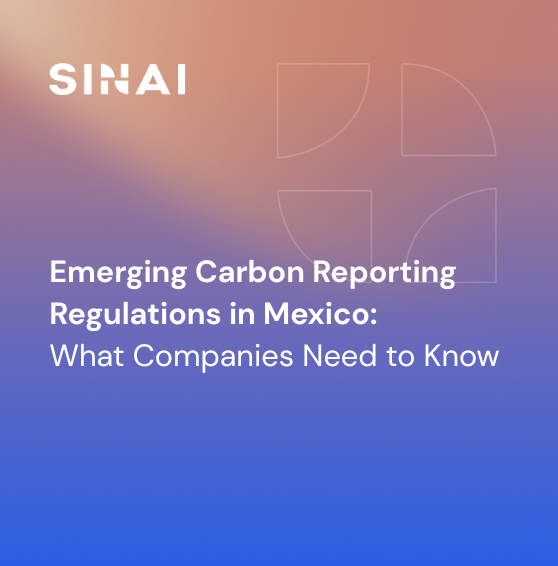
Implementing A Sustainability Strategy That Tackles Climate Risk
Transitioning from 'business as usual' to a meaningful net-zero pathway is integrating sustainability strategy into your firm’s business model.
But what does a comprehensive sustainability strategy look like? And what sustainability metrics should corporations look to include when bridging two strategies - sustainability and business - together?
The GHG emissions management specialists at SINAI define what it means to put in place a sustainability strategy that truly tackles climate transition risk. We also explain how your firm can develop a meaningful climate change strategy, along with best practice tips for aligning sustainability strategy with your existing business model.
Defining a sustainability strategy that tackles climate transition risk
Over the past decade, new principles and demands have emerged as firms attempt to make a real impact on climate change goals and targets.
Climate transition risk strategy is a prioritized set of actions your company commits to following through on, frequently through decarbonization. It provides an agreed framework to drive transformation, manage performance, focus investment, and bring together internal and external stakeholders when necessary.
Key elements of your firm’s sustainability strategy should be packaged into a framework with clear timelines, targets, and key performance indicators (KPIs) for various areas of your corporation. Successful implementation involves guiding employees, extensive consultation with investors, and putting in place systems of governance, external feedback, and review on a regular basis.
Identifying measurable benefits - alongside long-term risks and opportunities - can ensure your company’s strategy is resilient and creates real value for your firm and society as a whole.
Best practices for aligning sustainability and business strategies
Let’s explore tangible action your firm can take to make it as easy as possible to follow through on commitments outlined in your sustainability strategy while at the same time achieving key business goals.
From fostering a holistic cross-team approach when it comes to meeting goals set out in your sustainability strategy, to qualifying emissions in a way that’s accessible to board members and investors alike, these best practices can help bring your sustainability strategy directly into your business model.
A holistic, cross-departmental team approach
To anchor your sustainability strategy into your business model, the onus for developing the plan and meeting key targets must fall on all relevant teams across your firm - from finance and business development to operations - and not left only on the shoulders of the sustainability team.
By bringing more areas of your firm into the mix and fostering collaboration, your goals to tackle climate transition become organizational-wide goals, helping to cement them within your high-level business plan.
Smarter data integration
Your firm can automate data collection and calculations to make the necessary contributions from the various areas of your company as seamless as possible.
From calculating carbon inventories to better understand your firm’s emissions impact to what emissions you need to report to comply with relevant regulations, more innovative data integration can ensure accurate and straightforward connectivity and sharing of information to and from your firm’s relevant teams.
Intelligent scenario analysis
Effective risk management is about understanding what assets of your business are most at risk. Further, robust scenario modeling can help you determine what positive carbon opportunities exist that make sense for your firm to invest in, in the long term.
Inspect, finesse, transform, and model, letting your company discover helpful information, inform conclusions and support critical business decision-making as and when it’s needed, going beyond the goals set out in your sustainability strategy.
Quantifying emissions that are accessible to all
By setting specific emissions reduction targets within your firm’s policies and internal commitments, your firm’s goals become more visible and accessible to board members, directors, and investors alike.
An internal carbon budget can let all relevant parties know how much carbon there is left for the firm to emit, while an internal carbon price puts an optimal price tag on carbon reductions that’s transparent and meaningful.
Recent research by McKinsey found the energy, materials, and financial services industries are currently using internal carbon pricing the most:

Seamless integration of your sustainability strategy into your business model
Firms looking to take the lead in decarbonization need to join up their business and sustainability strategies in a meaningful way to achieve the impact needed to tackle climate change and protect the environment.
Those same strategies need to take into account and enable a collaborative environment across a firm’s relevant departments to review and feed into the necessary mitigation and risk modeling, focussing on the multi-dimensional nature of climate opportunities and risks.
Implementing an integrated sustainability strategy that tackles transition risk also makes it significantly easier for your firm to comply with Task Force on Climate-related Financial Disclosures (TFCD.)
SINAI has developed the world’s first decarbonization software that goes beyond the basic GHG emissions inventories and reporting currently offered from other emissions management platforms. We give industry-leading companies the ability to perform granular-level data modeling and multiple database opportunities, including emissions factors and mitigation options.
Leverage your firm’s data to migrate risk and utilize proprietary data to your competitive advantage.
To see our next-generation software solution in action, reach out for a demo today.

-2.png)
%20(7).png)








